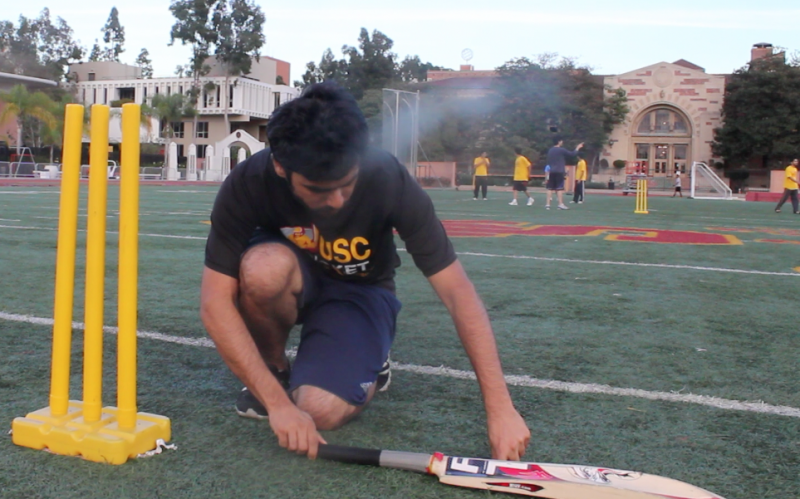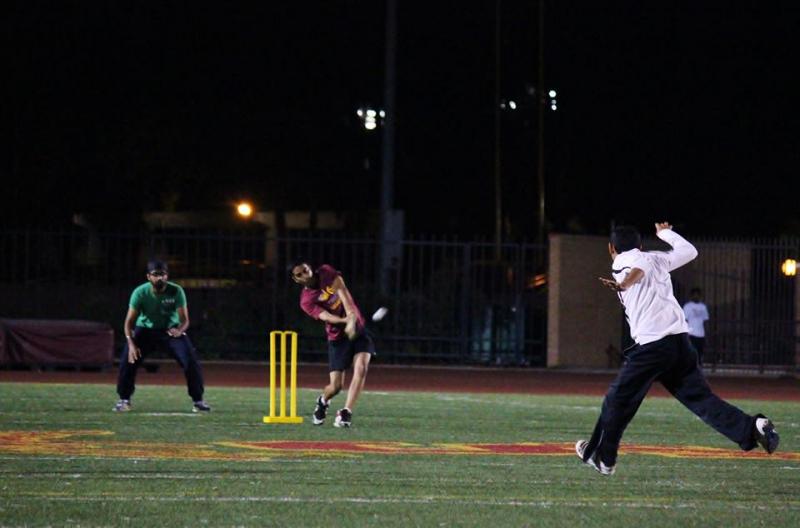A Different National Pastime: The Rise Of Cricket At USC

The batter times his swing and gets the ball right on the middle of his bat, making a soft, hollow sound worlds away from the loud PING of an aluminum baseball bat or the sharp CRACK of a Louisville Slugger. The ball lines softly to the left side, bouncing onto the track. One of the fielders quickly dodges the bypassing joggers and makes a throw to the cutoff man that whizzes over the heads of the spectators sitting at the turf’s edge. The cutoff man throws it back to the bowler waiting by the wicket.
In one swift motion of his right hand, the bowler catches the ball and punches the wicket before the batter can reach it. The poles of the wicket break off the base with a rattling plastic thunk. The batter is out, and the fielders roar their approval with cries of shabash, the Hindi word for ‘well done!’
Did you get any of that? Don’t worry. Not all of the club members started out growing up with the sport.
Audrey Moore, one of the club’s board members, only started watching cricket about a year ago. Now she is so hooked that has now joined one of the intramural squads.
“I was the only female player on my team, and it’s been a long time since we’ve had women on the team,” she said. “It was extremely nerve-wracking for me, but our team as a lot of josh [Hindi for enthusiasm]. Everyone pulls their weight and I was just able to get in the flow of it.”
SEE MORE: Sports SCene: Episode 9
It’s a shame most Americans can’t embrace the sport as much as Moore has, but it’s not hard to see why cricket remains a niche sport here and hasn’t experienced the extra bump that other European sports like F1 and soccer have received by America’s growing craving for sports.
MLB is experimenting with pitch clocks in an attempt to finally address the growing complaints that baseball games shouldn’t be three hours long. Meanwhile, the highest level of cricket matches – known as test matches – can go up to five days. Even the one-day matches in the ICC Cricket World Cup take around eight hours.
Then there’s the scoring. Americans like sports where scoring is always exciting. Home runs in baseball and goals in hockey and soccer are infrequent and are often accompanied by grandiose theatrics when they occur. On the other spectrum, touchdowns and slam dunks happen often, but are performed with the dramatic athleticism needed to provide an adrenaline rush.
Cricket rarely provides this. The length of the game makes home runs – known as fours and sixes, depending on whether the ball rolled out of the pitch or sailed into the stands – only exciting in the American sense if they come in bunches. In between these, batters will try to hit the ball deep enough that they can run between the wickets. In baseball, this would just create the possibility of scoring a run. In cricket, this is a run, and the runs pile up into the hundreds.
Cricket has the scoring frequency of basketball; the relaxed, pastoral tone of baseball; and the pace of the 24 Hours of Le Mans. That’s a cocktail that would never appeal to the palate of a sports culture that loves rapid-fire spectacle.

“One year, I was living with some other students in a four-room apartment,” says Gagan Singh, a USC alumnus who still comes by on Fridays to bat for one of the intramural squads. “One of the rooms was a 400-square-foot room we used just for cricket. We had twelve people in the room. It was so small we had to come up with special rules. If you hit the wall directly, it was an out. If you hit out the light it was a six.”
SEE MORE: Who Will Step Up As USC's New Top Wide Receivers?
When light bulbs aren’t being smashed, something much more meaningful happens: a chance to connect with other Indian students through the sport that, as Singh puts it, “runs through the blood of India.”
“I’m from North India,” Singh explained, “and before coming here I had never seen kids from other parts of the country. Since joining the club I’ve met other people who share so much in common.”
That’s the sort of discourse one can expect among college students coming from overseas, but USC’s status as one of the biggest recruiters of international students has turned the school into a hotbed for cricket. 10 years ago, a group of Indian engineering students started USC’s first hard ball cricket team. The team consists of both USC students who played in clubs before going to college and alumni who have gotten jobs in L.A. and continue to play for SC well after graduation. Today, it is the only college club to play in the top division of the Southern California Cricket Association.
Tarun Sandhu, the hard ball team’s manager, says that cricket has been so successful at USC that they’ve started spreading the sport to other universities. That’s why recent intramural matches have been host to a handful of young men sporting a color that triggers the ire of everyone on this campus: Bruin Blue.
“Back in the 1950s, UCLA once had a club team that performed very well in SCCA,” says Sandhu. “But at some point that stopped. We’re trying to help UCLA get a cricket program going again so…you know, we can beat them.”
When they’re not trying to find yet another way to top the Bruins in something, the USC Cricket Club hold screenings of cricket matches for anyone who wants a taste of what’s happening overseas. For the past month, students have packed lecture halls all night to watch India’s national team compete in the Cricket World Cup. Because the tournament takes place on the other side of the International Date Line, these viewing parties become all-nighters. Singh fondly recalls when India beat Sri Lanka to win the Cup four years ago, sending him and his classmates into a frenzy.
“It was around four in the morning when they won. We had been up all night but we were so excited. We were blaring music out of our cars and dancing until the sun came up.”

SEE MORE: Sports SCene: Episode 8
For Singh, the rivalry is very meaningful. His grandparents were born in Pakistan back when it was still a part of British Inida. His cousin served in the Indian Border Security Force and took part in the daily Wagah border ceremony. It takes place before sunset, and consists of elaborate marches, loud cheering from the spectators, tense handshakes after lowering of the flags, and a metric ton of bravado. But after the gate at the only border crossing between these two countries gets slammed shut, and the crowds all go away, the guards still bond over cricket.
“He told me how all the Indian guards would be watching India and Pakistan play cricket, and the Pakistan guards would be watching right on the other side of the wall. They’d be talking to each other over the wall through the whole match.”
Instead of being an extension of tense relations, the cricket rivalry between India and Pakistan allows both sides to turn decades of political and ideological strife into a day where they celebrate the sport so entwined in both of their cultures.
“When I meet Pakistani fans at the screenings, the only big difference is the team we root for,” Singh says. “We cook the same food, use the same spices, and wear the same clothes. We want to beat each other, but we also get a chance to come together.”
Unfortunately, neither Pakistan nor India got the bragging rights of winning cricket’s top prize. Both teams were eliminated by eventual champion Australia. First, Pakistan fell when they were held to 213 runs, a total that would be quickly eclipsed by the Aussies. Then, in the semifinal, India seemed to have Australia right where they wanted them, getting several of their top batters out midway through the first half. But Australia closed out with a flurry of runs to end their inning with 328, the most ever scored in a World Cup semifinal. India didn’t even come close to beating that target.
Still, for Taran Sandhu, the large turnout he’s gotten for these screenings and the growth of both the hard ball and intramural clubs over the last ten years is more than a good enough reason to celebrate.
"It only took us five days to completely fill the rosters for the intramural teams this year," Sindhu said. "It's been amazing seeing the passion that a lot of people at USC have for cricket. It's a great community that we have on campus and in our league, and if anyone wants to come and join us, we're here, playing intramurals every Friday night."



